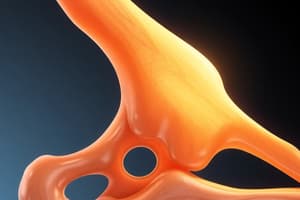Podcast
Questions and Answers
What type of cartilage provides a shock-absorbing function in the knees and intervertebral disks?
What type of cartilage provides a shock-absorbing function in the knees and intervertebral disks?
- Fibrocartilage (correct)
- Articular cartilage
- Hyaline cartilage
- Elastic cartilage
Which type of cartilage contains elastic fibers and contributes to the structure of the external ear?
Which type of cartilage contains elastic fibers and contributes to the structure of the external ear?
- Elastic cartilage (correct)
- Articular cartilage
- Fibrocartilage
- Hyaline cartilage
What is the primary function of bone tissue within the body?
What is the primary function of bone tissue within the body?
- Producing hormones
- Transporting oxygen
- Supporting the body's structure (correct)
- Facilitating nutrient absorption
What is the role of osteocytes within bone tissue?
What is the role of osteocytes within bone tissue?
What constitutes the liquid matrix of blood?
What constitutes the liquid matrix of blood?
Which feature distinguishes hyaline cartilage from fibrocartilage?
Which feature distinguishes hyaline cartilage from fibrocartilage?
How is bone tissue classified based on its rigidity?
How is bone tissue classified based on its rigidity?
What structure in bone contains osteonic canals interconnected by canaliculi?
What structure in bone contains osteonic canals interconnected by canaliculi?
What is the primary protein found in elastic fibers that contributes to their stretchiness?
What is the primary protein found in elastic fibers that contributes to their stretchiness?
Which of the following best describes loose connective (areolar) tissue?
Which of the following best describes loose connective (areolar) tissue?
Where is adipose tissue primarily located in the body?
Where is adipose tissue primarily located in the body?
What is a characteristic of dense connective tissue?
What is a characteristic of dense connective tissue?
In cartilage, where are chondrocytes located?
In cartilage, where are chondrocytes located?
Which type of connective tissue is primarily responsible for providing a supportive framework for various structures?
Which type of connective tissue is primarily responsible for providing a supportive framework for various structures?
What is a key property of reticular fibers?
What is a key property of reticular fibers?
Why do cartilage tissues heal slowly?
Why do cartilage tissues heal slowly?
What is the primary function of connective tissue?
What is the primary function of connective tissue?
Which type of connective tissue cell functions mainly as a scavenger in the immune response?
Which type of connective tissue cell functions mainly as a scavenger in the immune response?
What is a defining characteristic of connective tissues compared to epithelial tissues?
What is a defining characteristic of connective tissues compared to epithelial tissues?
What type of fiber in connective tissue is primarily responsible for strength?
What type of fiber in connective tissue is primarily responsible for strength?
Mast cells are significant in connective tissue for their role in releasing which substance?
Mast cells are significant in connective tissue for their role in releasing which substance?
Which of the following types of tissues is NOT considered one of the four major tissue types of the body?
Which of the following types of tissues is NOT considered one of the four major tissue types of the body?
How do connective tissues primarily aid in the body's protection?
How do connective tissues primarily aid in the body's protection?
What role does the fibroblast play in connective tissues?
What role does the fibroblast play in connective tissues?
Flashcards are hidden until you start studying
Study Notes
Cartilage Types
- Hyaline cartilage: Found in the nose, trachea, and articular surfaces of joints. Provides smooth surfaces for joint movement, reduces friction, and absorbs shock.
- Elastic cartilage: Found in the ears and epiglottis. Provides flexibility and support while maintaining shape.
- Fibrocartilage: Found in the intervertebral discs and menisci of the knee. Provides strong support and shock absorption.
Bone Tissue
- Function: Provides structural support, protects organs, facilitates movement, stores minerals, and produces blood cells.
- Osteocytes: Mature bone cells responsible for maintaining bone matrix and sensing mechanical stress.
- Structure: Consists of a hard, calcified matrix with a network of cells and canals.
Blood
- Liquid matrix: Plasma, composed of water, proteins, and dissolved substances.
Connective Tissue
- Characteristics: Cells embedded in a matrix of extracellular material (ground substance and fibers).
- Loose connective tissue (areolar): Found beneath epithelial tissues, provides support and allows for diffusion of substances.
- Adipose tissue: Specialized loose connective tissue storing fat for energy and insulation, located beneath skin and surrounding organs.
- Dense connective tissue: Contains more tightly packed fibers, provides strength and support, found in tendons, ligaments, and fascia.
- Fibers:
- Collagen fibers: Strong and flexible, provide tensile strength.
- Elastic fibers: Stretch and recoil, provide elasticity.
- Reticular fibers: Thin and branching, form delicate networks supporting organs.
- Chondrocytes: Cartilage cells located in lacunae, responsible for synthesizing and maintaining cartilage matrix.
- Mast cells: Release histamine and other inflammatory mediators, vital for immune response and wound healing.
- Fibroblasts: Responsible for synthesizing the extracellular matrix of connective tissue, including fibers and ground substance.
Other Points
- Bone classification: Classified as compact (solid and dense) or spongy (porous and lighter).
- Osteonic canals: Found in compact bone, contain blood vessels and nerves.
- Canaliculi: Small channels connecting osteocytes within bone.
- Elastic fibers: Contain the protein elastin, responsible for their stretchability.
- Cartilage healing: Limited healing capacity because of the avascular nature of cartilage, lacks direct blood supply.
- Connective tissue functions: Support, protection, insulation, transportation, and storage.
- Connective tissue vs. epithelial tissue: Connective tissue cells are sparsely distributed in a matrix, while epithelial tissue cells are closely packed with minimal extracellular space.
- Connective tissue protection: Provides physical barriers and support to organs and tissues.
Studying That Suits You
Use AI to generate personalized quizzes and flashcards to suit your learning preferences.



